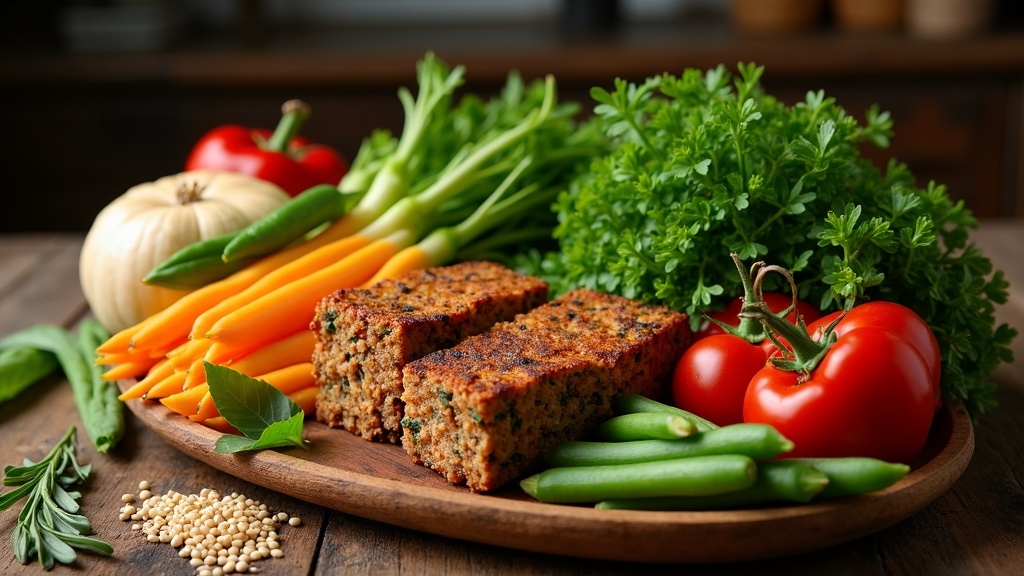The decision to cut back on meat isn’t just about food; it’s about trying new flavors, supporting your well-being, and exploring everything else your plate can offer.
For most people (including me), switching away from a meatfocused menu can feel overwhelming at first.
Going slow works best for many, and there are plenty of strategies to make it an enjoyable adventure instead of a chore.
Here, I’m sharing my firsthand tips for reducing meat consumption gradually, all based on plenty of kitchen experiments, research, and a good bit of trial and error.

Why Consider Reducing Meat Consumption?
The reasons for eating less meat can vary—it might be about looking after your health, lowering your impact on the planet, or simply saving money.
Research consistently links eating less meat with lower risks for heart disease, certain cancers, and type 2 diabetes (Harvard T.H. Chan School of Public Health).
On top of that, livestock farming accounts for a significant portion of greenhouse gas emissions; even just swapping out a handful of meals each week helps reduce your footprint (UN Environment Programme).
You don’t have to be completely vegetarian to see positive changes—every meal makes a difference.
Plus, cutting back is a solid excuse to play with different recipes, get into new cuisines, and stumble upon ingredients you never thought to try before.
Getting Started With Reducing Meat: What to Expect
Cutting back shouldn’t mean ditching your favorite foods overnight. Expect it to be a process. Old habits might hold on, and cravings may show up, especially if meat has always led your meals.
I started with small changes, like adding beans to tacos instead of ground beef or swapping in plantbased sausages on pizza.
Both my taste buds and my routines adapted more smoothly by making subtle changes instead of dramatic ones.
It’s worth predicting a bit of trial and error—some meatless meals might not become instant classics, but you’ll also stumble upon surprise favorites.
Planning ahead and having reliable replacements on hand go a long way.
Handy Tips to Lower Meat Intake Gradually
Here are a handful of ideas that served me and lots of others looking to cut back the easy way:
- Start Small With Meatless Days: Try setting aside one or two days per week for no meat at all. “Meatless Monday” is classic. When ready, bump up the frequency as it fits your routine.
- Simple Swaps Work Best: Trade chicken for chickpeas, or mince for lentils in tacos, soups, and stews. Tofu, tempeh, and seitan soak up sauces and spices, making them satisfying replacements.
- Double Up the Plants: When you do cook meat, just use less. Add more veggies, whole grains, beans, or lentils to the dish. You still get your favorite taste but in a balanced way.
- Get Into Global Cuisines: Many cuisines around the world rely less on meat. Indian chana masala or Mediterranean falafel are already packed with flavor, so you’re not missing a thing.
- Stay True to Favorite Meals: Instead of scrapping traditions or comfort eats, try new versions with plantbased ingredients. Veggie burgers, lentil Bolognese, or mushroom tacos can serve up the same comfort, just with a twist.
What to Watch For When Cutting Back on Meat
When you adjust your diet, a few things are worth keeping an eye on to make sure you feel great and enjoy what you eat.
- Balanced Nutrition: Reducing meat is straightforward, but you’ll want to fill any nutritional gaps. Pay extra attention to protein, iron, vitamin B12, and zinc. Beans, tofu, eggs, dairy, and whole grains help fill the gaps. For B12, fortified nutritional yeast or a supplement could be helpful if you cut out meat almost entirely.
- Satisfaction Factor: There’s a common worry about not feeling full without meat. Hearty sides—like roasted potatoes, textured vegetable protein, or nuts—add real satisfaction. Keeping portions sizable and loading up on fiber keeps hunger away.
- Cooking Adjustments: Plantbased foods may need a little experimenting. Lentils might need extra seasoning to match the depth of beef, or tofu picks up flavor best with a good marinade. Don’t hesitate to try new spices and sauces; your taste buds may find something new to love.
Protein Sources for Meatless Meals
It’s actually easy to meet your protein needs, even if you’re used to relying on animal foods. Here are some tasty staples to put to work in your kitchen:
- Beans & Lentils: Black beans, chickpeas, kidney beans, and lentils fit into nearly anything, from chili to pasta salad.
- Tofu & Tempeh: Both work their magic, soaking up marinades and spices. Tofu scrambles, vegetable stirfries, or grilled tempeh cubes are quick and satisfying.
- Whole Grains: Quinoa, farro, and barley not only provide protein but also add a nutty bite to meals.
- Eggs and Dairy: If you still use these, eggs and yogurt are super easy options for breakfast or snacks.
- Nuts & Seeds: They offer crunch, healthy fats, and nutrition for salads, oatmeal, or even savory bakes.
Taste Upgrades: Flavor Boosters for MeatFree Cooking
The biggest surprise for me was how much seasoning and flavor layering can do.
Umami-rich add-ons like mushrooms, sundried tomatoes, tamari, miso, and smoked paprika fill in where meat once shined.
Roasting your veggies brings out sweet, rich undertones, while sauces like chimichurri, tahini, or zippy salsas add real zing.
Try playing with dressings, dips, and heaps of fresh herbs—you just might stumble upon something new that sticks.
RealLife Situations: How to Stay Consistent
Daily routines can make it hard to stick with new eating habits, but a little planning smooths the way.
- Meal Prep: I like to keep a few plantbased basics on hand in the fridge. Roasted vegetables, cooked lentils, or a jar of hummus mean lunch is just a minute away.
- Eating Out: These days, most restaurants offer veggie options. Don’t hesitate to ask for substitutions or extra veggies.
- Social Occasions: Potlucks and barbecues are much easier if you bring a crowdpleaser like veggie chili or an eye-catching salad. Even meat eaters are often game to dig in.
- Cravings: Sometimes a familiar taste is all you want. Meat alternatives today are impressive; burgers, chicken nuggets, and plantbased sausages can make the transition simple—even if you only use them now and then.
Frequently Asked Questions
Here are some questions people often ask about getting into a meat-light lifestyle:
Question: How long does it take for taste buds to adjust to less meat?
Answer: It’s different for everyone, but usually within a couple of weeks, meals become as tasty as ever. Spice blends, sauces, and new ingredients make the switch smoother.
Question: How do I make sure I’m getting enough protein?
Answer: Mix up sources—beans, tofu, lentils, whole grains, eggs, and dairy (if you use them) add up fast. Simple tracking tools like Cronometer or MyFitnessPal help you double-check your nutrition, giving you peace of mind.
Question: Won’t my food budget go up?
Answer: In most cases, you’ll spend less! Dry beans, lentils, grains, and seasonal produce are some of the cheapest proteins available. Skip pricier premade alternatives and you’ll see your grocery bill drop.
Extra Advice for the Switch
Be gentle on yourself as you adjust. Everyone’s pace is unique, so take it at your speed.
Celebrate small wins, learn from the dishes that flop, and enjoy the adventure of unearthing new recipes.
The process can turn out to be not only smoother than expected but surprisingly eye-opening and fun.
Cutting back on meat opens up a world of new recipes, lunches, and snacks that you might not have tracked down otherwise.
With some planning, an open mind, and a willingness to experiment, you might just find your next favorite meal is completely plantbased.
